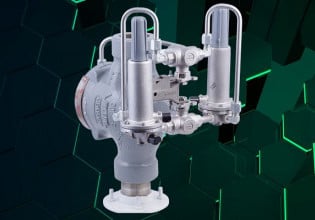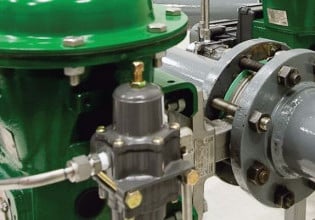The Importance of Collecting and Using Maintenance Data
Learn about how a CMMS helps maintenance teams increase the quality of decisions and improve efficiency by providing timely access to maintenance data that is current, accurate, and complete.
The quality and value of a decision depend on the quality of the data on which it is based. As in any other aspect of maintenance management, decision-making and operational performance depend heavily on ensuring that the right kind of data is available when required by the relevant decision-makers.
This is where having an effective data collection tool, such as a computerized maintenance management system (CMMS), comes in handy. A good tool will automate the entire process of data collection, data communication, data maintenance, data cleansing, and data processing. This ensures a greater level of accuracy, meaningfulness, and predictive value for making useful decisions.

Figure 1. By having access to maintenance data, maintenance management teams can improve the quality of their operations. Image used courtesy of Canva
What Is Maintenance Data?
Maintenance data is all the data that helps maintenance managers identify issues throughout an organization. It helps technicians carry out maintenance tasks on time and provides accurate and timely reports regarding maintenance activities.
In short, it includes all the data that goes into a maintenance support system and all the data that comes out of it.
Maintenance data can include documentary data, such as:
-
Policies and procedures
-
Workflows
-
Organizational charts
-
Technical manuals
-
Job descriptions
-
Standard operating procedures (SOPs)
Maintenance data also includes information about the performance of equipment and machines, such as processing speed, temperature, noise, output, and so on.
The quality of operational maintenance depends on the availability of historical and real-time data. At the managerial level, data comprises details about the historical performance and productivity of the asset, past work done on the machine, and so on.
It is also convenient to divide maintenance data into data that is gathered through devices, such as sensors, monitors, and other wireless equipment. This minimizes the need for physical or manual inspection of machines and data that is produced from within a CMMS, through analyzing data that is already present within the system.

Figure 2. Repair time can be reduced by using maintenance data to create a predictive maintenance strategy. Image used courtesy of Canva
Why Do We Need Access to Maintenance Data?
Having timely access to maintenance data that is current, accurate, and complete is important for a variety of reasons. Most importantly, it helps managers to stay updated on the performance of every piece of equipment and device. This means that if there are any potential risks of damage or disruption, they can be addressed in time.
The presence of errors and missing data in work orders can have a domino effect on the overall quality of maintenance decisions. Thus, there is a predictive value to maintenance data that cannot be ignored as it helps to prevent the need to shut down operations to fix a repair that could have been spotted earlier with some better planning.
By using maintenance data, 91% of manufacturers that created a predictive maintenance strategy saw a significant reduction in their repair time.
Maintenance data also helps managers to create jobs, work orders, schedule maintenance tasks, and assign jobs to different people on the maintenance team. To do this well, and to avoid any gaps in scheduling or errors in specifying the job details, it is important to have access to complete and accurate data about the real-time activity and condition of the equipment.
Nowadays, by installing a CMMS, maintenance managers can gain instant access to all of the above data, which can help them plan the daily and monthly maintenance activities as well as plan for the longer term by means of renewing contracts, hiring more staff, budgeting, and investing in new devices for the monitoring and tracking of equipment. The accuracy of predictions determines the efficiency of maintenance and service systems in organizations.
By ensuring that maintenance data is available when and where it is needed, maintenance managers decide which assets need more attention than others. As well as what kind of metrics or KPIs need to be developed to monitor assets, how frequently each asset needs to be inspected, and what kind of activities need to be performed in order to keep it running in optimum condition for longer.
How Best To Collect and Analyze Your Maintenance Data
When it comes to collecting maintenance data, there are ways of doing it manually and automatically.
Manual procedures are likely to produce more frequent errors, which may never be detected, but their consequences can be costly. These either result in overlooking a risk factor or investing too much in an area that did not require it.
Automated processes, such as investing in a CMMS, can reduce the human factor and increase the reliability of data that is fed into the maintenance system. Automated processes require investment in technology, such as sensors, processors, and other devices, but the returns are high in the form of better machine performance and reduced costs of operational maintenance.
Today, there are several devices that are set up with different kinds of machines to monitor their activity and feed the results into a CMMS. Sensors that monitor and track data about the noise, temperature, fumes, vibrations, and other aspects of a machine’s performance can be installed with every machine. These are wireless, which makes them unobtrusive and easily connectable to a network.
Automation also helps improve the quality of data linkages within a maintenance system. In other words, it helps to make the data available for multiple uses, like drawing up a work order, making a schedule, or preparing budgeting reports by centralizing all raw data in one repository.
There is no need to gather data every time for a different purpose. Not only does this help to save time, but it also increases the consistency and quality of reporting because the same data is being used by every member of the team.
Figure 3. Using a CMMS ensures access to reliable maintenance data and allows employees to make maintenance requests on a single platform. Image used courtesy of Canva
Key Benefits of Using a CMMS To Collect Your Maintenance Data
A CMMS acts as a centralized database that helps maintenance teams to maximize the productivity of their assets. If the quality of maintenance data helps managers to perform maintenance activities more proactively and identify maintenance needs right when and where they happen, then the productivity and efficiency of an organization can increase significantly.
The credibility of the maintenance management team also increases when they are able to provide data-backed decisions and reports to senior management, be it for budgeting or planning purposes.
Since data efficiency is so crucial for organizations in the age of information, teams can also use a CMMS to ensure assets such as servers, data centers, and other IT equipment suffer as little downtime as necessary when performing routine tasks.
As far as regular maintenance activity is concerned, a CMMS provides a single platform for all employees to make maintenance requests. It helps to bring down the number and frequency of machine failures, improves the quality of maintenance activity scheduling, and enables better performance management of the staff. Through this feature, managers get a complete overview of which departments or which assets generate the most requests, as well as which members of the maintenance team are specialized to perform specific maintenance tasks and what costs are incurred on maintenance activities.
Data is essentially the bedrock of decisions and strategies. Having access to reliable maintenance data with the flexibility to analyze and present it for different purposes increases the quality of decisions and improves efficiency in the long run.







